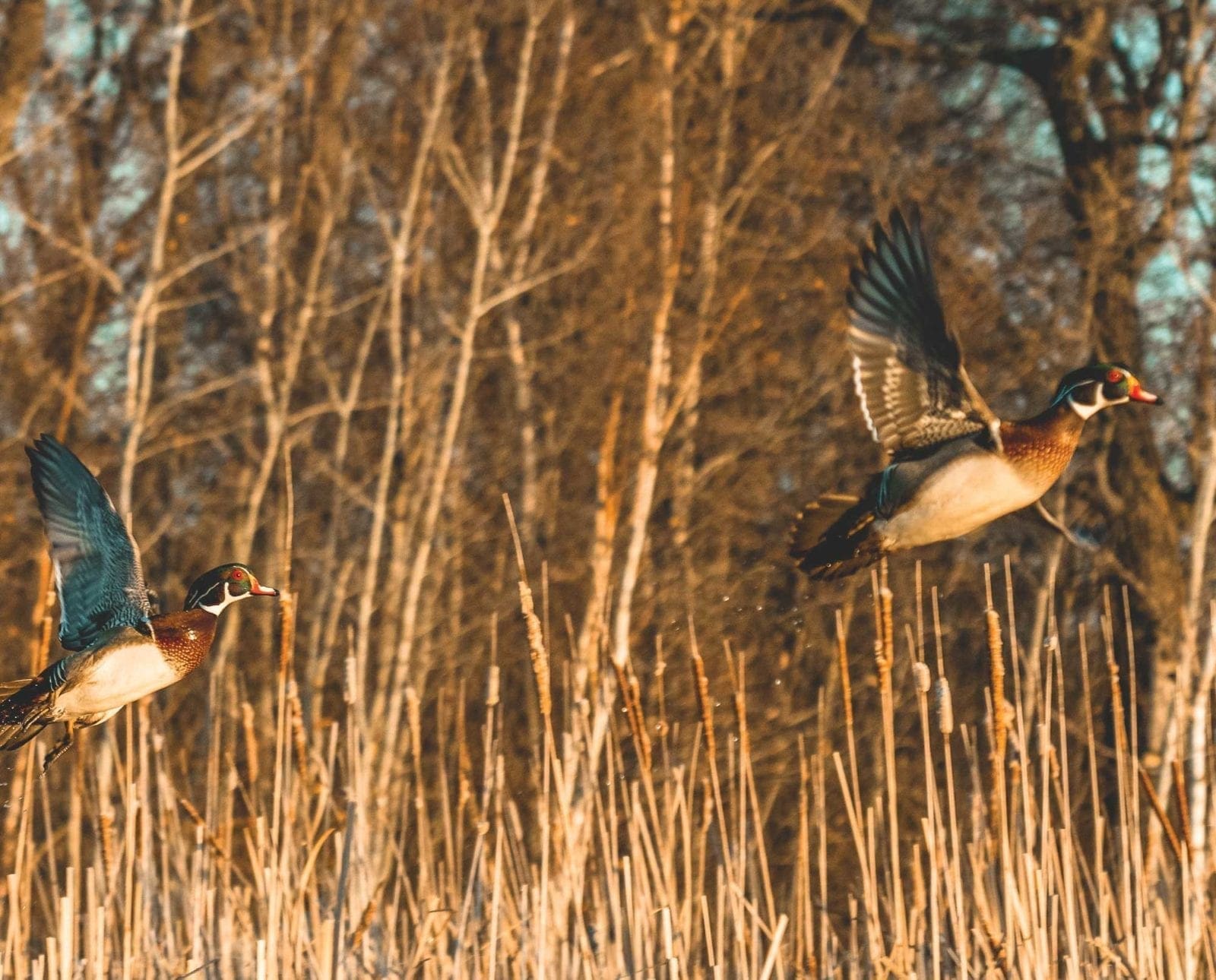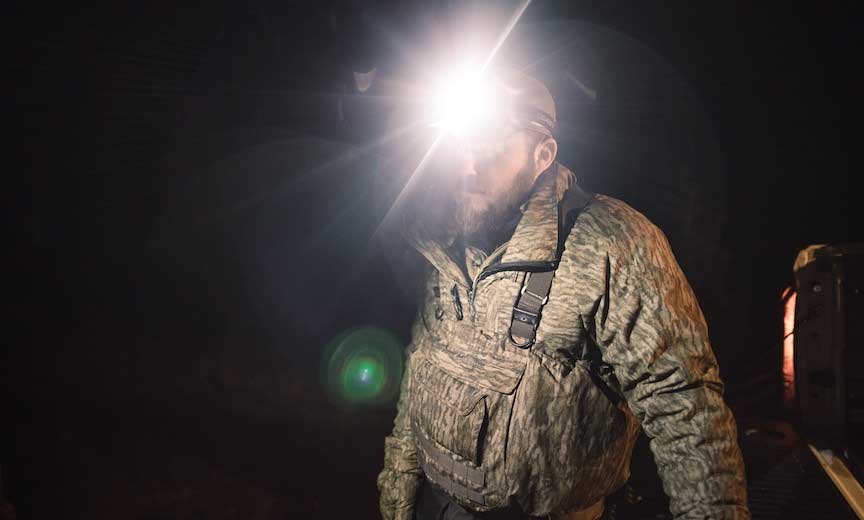Home » Waterfowl Hunting » The Basics of Scouting for Ducks
The Basics of Scouting for Ducks

Using sheer grit and determination to figure out where to find ducks
I checked the map on my phone to confirm the location. “Only a mile to go,” I thought as I rumbled down a rutted gravel road cutting across a large section of public land. Passing under towering pine trees which seemed to look down on me through the early morning moonlight, questions began to circle through my head: “Will the birds fly this morning? Do I have enough decoys? Will the patch on my waders hold?” Above all, a more important thought also lingered in my mind: “Did I choose the right spot?”
Duck hunting is a sport of preparation and planning. Lots of hard work and time goes into making a successful hunt, which is what makes it so rewarding. From calling to concealment, there are many factors that will affect the outcome of a hunt, but in the end it all boils down to one thing: you need to be where the birds are. The only reliable way to do this is to scout.
If you google “scouting for ducks,” countless results go into detail on when and where to find birds. Starting my journey as a new waterfowl hunter last year, the sheer amount of information overwhelmed me. Articles and YouTube videos went into depth about finding roosts and feeds as well as planning a hunt once birds were found, but for the most part they all left out the basics I needed to get started. How was I supposed to scout if I didn’t even know where to start looking for birds?
How to get started scouting for ducks
I pulled the truck over to the side of the road and once again checked my phone to make sure we were in the right location. Opening my door, I was met with the sound of wind rustling the few golden leaves still hanging on to the aspen trees. Joining me on this mid-October hunt was my buddy, Tyler. We were both amateur waterfowl hunters who lacked experience but made up for it in sheer determination. We spent every weekend of the fall fixated on chasing ducks. The spot Tyler and I were hunting this morning was a 10-acre beaver pond located a half mile from the nearest road or trail. There was no way to find this secret spot unless you happened to stumble upon it while hiking through the woods. So how did I come across it?
Although I was overwhelmed, I decided I needed to start the scouting process somewhere. Living in Wisconsin, the middle of winter was definitely not the best time to do this. Several feet of snow blanketed the landscape and all of the lakes, ponds, and marshes were covered in ice. Obviously this ruled out most traditional scouting methods. Although my options were limited, visions of mallards flipping their wings and dropping into the decoys were more than enough motivation for me to begin preparing for the fall. To do this, I began “internet scouting.”
Using the internet for off-season duck scouting
The Department of Natural Resources provides locations of public land on its website, which is where I started my search. From there I used Google Maps to search these areas for potential hunting spots. Maybe it was just winter boredom, but the process of internet scouting started to constantly occupy my thoughts. Many nights that should have been spent doing homework were instead used to scour maps. Whenever I found a promising location, I used Google’s My Maps to mark the location. Using a system of symbols and colors, I organized the spots, which would allow me to check them more efficiently once the season began. This process continued throughout the winter and into the summer. By the time duck season rolled around at the end of September I had compiled a list of around 50 potential spots. Among this list was the beaver pond we had chosen to hunt this morning. By itself this spot would not have been great, but its proximity to a heavily hunted marsh made it intriguing. My idea was that birds would seek refuge in this protected little spot to avoid pressure. There was only one way to test this theory: hunt.
Test your research by getting out to hunt
I slung a decoy-filled backpack over my shoulders and began an arduous trek to the pond. Looking into the woods, the beams of light cast from our headlamps were met with an almost impenetrable wall of brush. Filled with optimism for the morning hunt, Tyler and I were unfazed and powered through the undergrowth hoping our hard work would be rewarded. Slogging through the willows and tag alders, we finally reached the edge of the pond 20 minutes later. Both drenched in sweat under our neoprene waders, we took a break to catch our breath and unpack our gear. This was where the final phase of scouting came in.

The day before our hunt I made the same trek armed with hiking boots and a pair of binoculars instead of waders and a shotgun. I had high hopes for the pond based on the aerial photos but I had no idea what it would look like on the ground. I desperately hoped I would find the duck-filled spot I had dreamed about all winter. Before I even reached the water an unmistakable squeal caught my attention. Whoweep! Whoweep! I broke through the last trees just in time to watch a pair of wood ducks burst off the surface and launch into the air. Before I even had time to get excited, they were followed by several mallards. The next couple of seconds, ducks seemingly appeared out of nowhere, jumping from hidden pockets in the reeds lining the shore. Wood ducks, mallards, and even a few black ducks took flight and filled the sky. I stared in awe. Scouting actually paid off! After watching in amazement for what seemed like an hour, I finally made my way back to the truck filled with anticipation for the next morning.
Reaching the spot the birds had been, I waded out as far as I could without going over my waders and carefully set out the four mallard decoys I had been able to fit in my backpack. After making sure they were placed correctly, I retreated to a muskrat hut we had chosen as a blind and waited for the sun to come up. As soon as it began to get light the marsh came to life. Above my head I could hear the sound of wings and saw the occasional silhouette of a wood duck zipping over the decoys. My heart began to beat faster as shooting time grew closer. When 6:33 finally appeared on my watch we dropped shells into our guns and closed the actions. This was finally it. Months of planning and anticipation had led to this moment. All that was left to do now was wait.
Finding sweet success after all the scouting work
Fortunately we didn’t have to wait long. Minutes after shooting time a lone duck coming towards the decoys caught my attention. “One out front,” I whispered. Tyler nodded in recognition. Only inches off the water, the duck banked its wings showing powder blue wing patches. “Take ‘em!” I yelled, breaking the morning silence. A single gunshot echoed across the pond from Tyler’s shotgun as the blue-winged teal splashed into the water. We celebrated the first duck of the morning with a quick high five but returned to the blind hastily after watching a flock of wood ducks zip by just out of range. For the next hour we watched birds fly over the pond. I blew my call as loud as I could but the birds paid us no attention.
Just when I thought the action was starting to fade, a trio of mallards got up from the far end of the pond. Again I blew my call, but this time the birds showed more interest. They passed just out of range and circled over the pond. I continued to call and finally they started to drop altitude and locked up on the decoys. Once they got close the birds drifted to my side of the decoys. This was it! I called the shot and rose up to shoot. Picking out the lead bird, I fired. The mallard faltered and began to fall. A follow-up shot folded the young drake as the others flew off to live another day. As soon as the duck hit the water I lowered my gun and trudged through the mud as fast as I could to retrieve it. I was overcome with excitement when I finally reached it. All the hard work paid off! No other feeling could match the satisfaction I felt at that moment. Grabbing the duck in one hand and my gun in the other, I raised my arms to the sky in triumph.“Yes!” I shouted. This moment alone made all of the effort that went into the hunt more than worth it.
We sat for a little while after shooting that mallard but the ducks stopped flying. For most veteran duck hunters, only shooting two birds in a morning might be considered a bad hunt, but for me it was a huge success. Those birds represented the reward for all of the scouting and preparation that made this hunt possible. To me there is nothing more rewarding than putting in the time to find birds and having it all come together when you finally hunt. Whether you are a seasoned waterfowler who has hunted the same spot your whole life or a beginner just getting into the sport, I suggest doing a little research, busting out your waders, and scouting some new spots. I’m willing to bet the results won’t disappoint you.



